Ordered 3 March 1899 Laid down 7 August 1901 Launched 22 August 1903 | Awarded 10 January 1901 Construction started 7 August 1901 Builder William Cramp & Sons | |
 | ||
Namesake Commonwealth of PennsylvaniaCity of Pittsburgh, Pennsylvania Cost $3,890,000 (contract price of hull and machinery) | ||
The second USS Pennsylvania (ACR-4/CA-4), also referred to as Armored Cruiser No. 4, and later renamed Pittsburgh, was a United States Navy armored cruiser, the lead ship of her class.
Contents
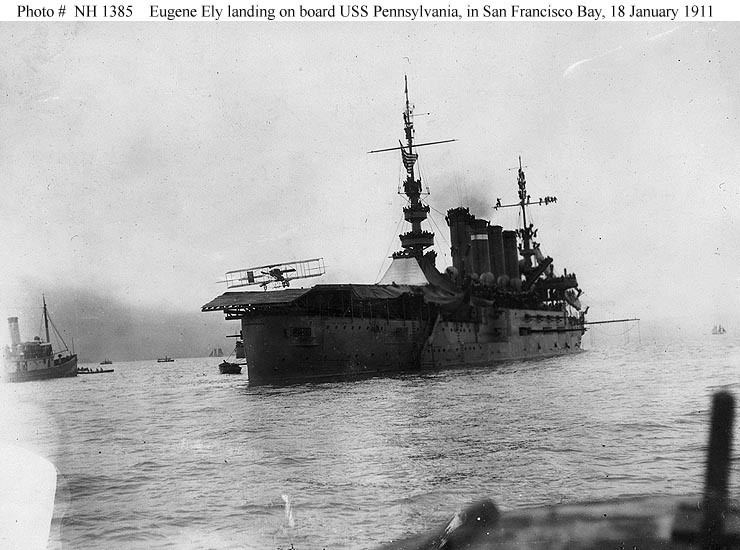
She was laid down on 7 August 1901 by William Cramp and Sons of Philadelphia, launched on 22 August 1903, sponsored by Miss Coral Quay, daughter of Senator Matthew S. Quay of Pennsylvania, and commissioned on 9 March 1905, Captain Thomas C. McLean in command.
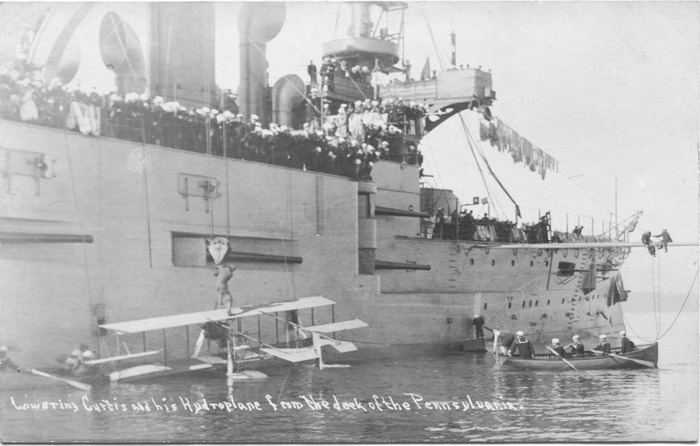
Pre-World War I
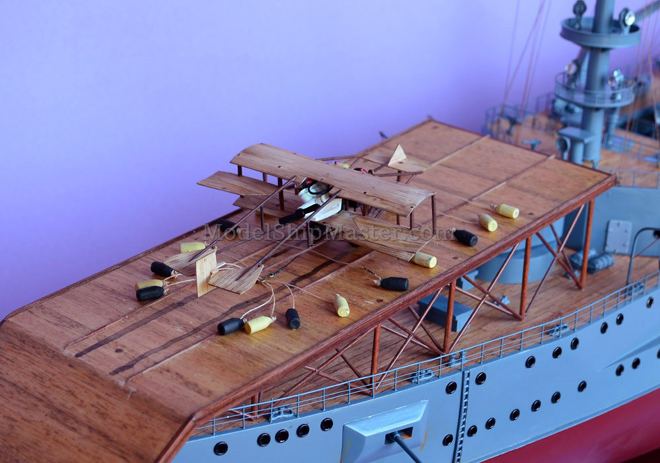
Pennsylvania operated on the east coast of the United States and in the Caribbean Sea until 8 September 1906, when she cleared Newport for the Asiatic Station, returning to San Francisco on 27 September 1907 for west coast duty. She visited Chile and Peru in 1910.
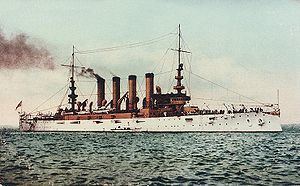
On 18 January 1911, a plane flown by Eugene Ely from the Tanforan airfield in San Bruno, California landed on a platform constructed on her afterdeck. This was the first successful aircraft landing on a ship, and the first using a tailhook apparatus, thus opening the era of naval aviation and aircraft carriers.
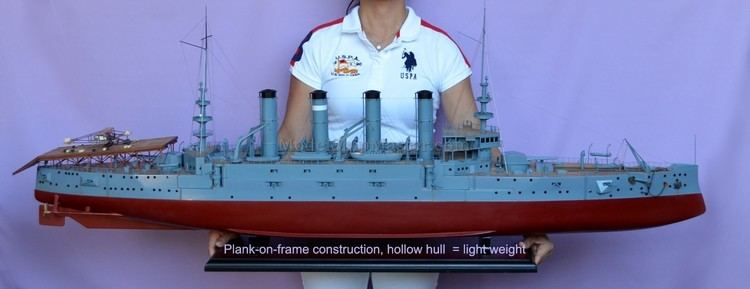
While in reserve at Puget Sound from 1 July 1911 – 30 May 1913, the cruiser trained naval militia. She was renamed Pittsburgh on 27 August 1912 to free the Pennsylvania name for a new battleship.
World War I
Recommissioning, Pittsburgh patrolled the west coast of Mexico during the troubled times of insurrection that led to American involvement with the Veracruz landing in April 1914. Later she served as flagship for Admiral William B. Caperton—Commander in Chief, Pacific Fleet—during South American patrols and visits during World War I. Cooperating with the British, she scouted German raiders and acted as a powerful deterrent against their penetration of the eastern Pacific.
Future Rear Admiral Ellis M. Zacharias served as a line officer aboard Pittsburgh during World War I. Future Governor of American Samoa George Landenberger commanded the vessel.
Inter-war period
Returning to the east coast, Pittsburgh prepared for duty as flagship for Commander, US Naval Forces in the eastern Mediterranean, for which she sailed from Portsmouth, New Hampshire on 19 June 1919. Cruising the Adriatic Sea, Aegean Sea, and Black Sea, she joined in the massive relief operations and other humanitarian concerns with which the Navy carried out its quasi-diplomatic functions in this troubled area. In June 1920, she sailed north to visit French and British ports and cruise the Baltic Sea on further relief assignments.
On 9 September 1920, she ran aground on rocks in the Baltic Sea off Libau. She was assisted by HMS Dauntless and Frederick; Frederick escorted her to Sheerness Royal Dockyard, Kent, England which she reached at 10:00 o'clock in the morning of 23 September. Before 12 October she had moved up river to Chatham Dockyard where she went into dry dock. On that date a team from Pittsburgh routed a team of British officers 21-8 at baseball. The following month, with Pittsburgh still in dry dock, a court martial absolved Captain Todd of blame for the grounding but the navigator and watch officer were held accountable. She returned to decommission at Philadelphia on 15 October 1921.
Recommissioned on 2 October 1922, Pittsburgh returned to European and Mediterranean waters as flagship of Naval Forces Europe, arriving in Gibraltar on 19 October. On 23 October, she hoisted the flag of Vice Admiral Long when Utah returned to the US. By 10 July 1923 Pittsburgh was in the harbor at Cherbourg, France, to disembark 3 officers and 60 enlisted men of her Marine Detachment. They were detailed to travel to the dedication of the Belleau Wood National Monument to the American Expeditionary Force. Belleau Wood was where the US Marine Corps made a famous stand during the Allied Campaign of 1918. Pittsburgh became flagship for two of the Commanders-in-Chief, US Naval Forces European Waters, Admiral Philip Andrews in 1924–1925 and Vice Admiral Roger Welles in 1925–1926.
The ship arrived at New York on 17 July 1926 to prepare for flagship duty with the Asiatic Fleet, during which time she was partially refitted, including the removal of her forward stack (making her unique to her class) and removal and plating over several 3-inch guns. She sailed on 16 October for Chefoo, arriving on 23 December. Early in January 1927, she landed sailors and Marines to protect Americans and other foreigners in Shanghai from the turmoil and fighting of the Chinese power struggle. When Chiang Kai-shek's National Revolutionary Army won control of Shanghai in March, Pittsburgh resumed patrol operations and exercises with the Asiatic Fleet. Closing her long career of service, she carried the Governor General of the Philippines, Dwight F. Davis, on a courtesy cruise to such ports as Saigon, Bangkok, Singapore, Belawan, Batavia (Jakarta), Surabaya, Bali, Makassar, and Sandakan, returning to Manila on 15 April 1931. Six days later, she steamed for Suez en route to Hampton Roads, arriving on 26 June. She was decommissioned on 10 July, and under the terms of the London Naval Treaty, sold for scrapping to Union Shipbuilding, Baltimore, Maryland on 21 December.
Pittsburgh's bow ornament was presented to the Carnegie Institute of Technology in Pittsburgh, Pennsylvania, where it was installed overlooking Junction Hollow at the western edge of the school's campus. Today, the ornament is on display at Soldiers and Sailors National Military Museum and Memorial; a replica of it is still in place at the modern Carnegie Mellon University.
Memorial bell
The number 3 bell at Rochester Cathedral, England, bears the inscription "U.S.S. PITTSBURGH IN MEMORY OF 1920".
For many years the reason for this inscription was a mystery. Then a researcher found the explanation in the Chatham Newsof 17 December 1920. That issue included a letter from Captain J.W. Todd who commanded Pittsburgh in 1920. Captain Todd thanked the Dean of the Cathedral for various hospitality events during the two and a half months that Pittsburgh was in dry dock at Chatham. He enclosed a cheque for £52 10s to pay for the recasting of the bell, and suggested the inscription.
